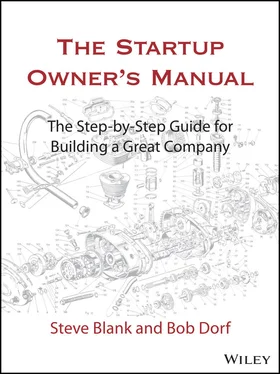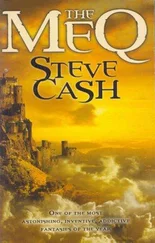1 ...7 8 9 11 12 13 ...22 The chorus of investor voices says, “Why, of course that’s what you do. Getting the product to market is what sales and marketing people do in startups. That’s how a startup makes money.” This is deadly advice. Ignore it. Focusing only on launch results in a “fire, ready, aim” strategy that ignores the customer discovery process—a fundamental and generally fatal error. Obviously, every startup or company wants to get a product to market and sell it, but that can’t be done until the company understands who it’s selling to and why they’ll buy. The forced march ignores the iterative loop that says, “If our assumptions are wrong, maybe we need to try something different.” It shuts off the “build, test and learn” flow and assumes that customers will come based merely on good engineering execution.
Time after time, only after launch does a startup discover that not enough customers visit its website, play the game, bring their friends, or convert to orders. Or it discovers that early customers don’t scale into a mainstream market, or the product doesn’t solve a high-value problem, or the cost of distribution is too high. While those discoveries are bad enough, the startup is now burdened with an expensive, scaled-up sales and marketing organization—effective only at burning mountains of cash—that’s now trying to figure out what went wrong and how to fix it.
At Webvan, the dot-com mania may have intensified the company’s drive to launch, but its single-minded focus was typical of most startups. At first customer ship, Webvan had close to 400 employees. It hired more than 500 more during the next six months. By May 1999, the company had opened its first $40 million distribution center, built and scaled for a customer base it could only guess at, and it had committed to 15 other distribution centers of the same size. Why? Because the Webvan business plan said to do so, regardless of whether the customers agreed.
4. Emphasis on Execution Instead of Hypotheses, Testing, Learning, and Iteration
Startup cultures emphasize “get it done, and get it done fast.” So it’s natural that heads of engineering, sales and marketing all believe they are hired for what they know how to do, not what they can learn. They assume that their experience is relevant to this new venture and that all they need do is put that knowledge to work managing the execution that’s worked for them before.
While established companies execute business models where customers, problems, and necessary product features are all knowns, startups need to operate in a “ search ” mode as they test and prove every one of their initial hypotheses. They learn from the results of each test, refine the hypothesis and test again, all in search of a repeatable, scalable and profitable business model.
Relentless execution without knowing what to execute is a crime.
In practice, startups begin with a set of initial hypotheses (guesses), most of which will end up being wrong. Therefore, focusing on execution and delivering a product or service based on those initial, untested hypotheses is a going-out-of business strategy.
In contrast, the traditional product introduction model assumes that building a startup is a step-by-step, sequential, execution-oriented process. Each step unfolds in a logical progression that can be captured in a PERT chart (a project management technique that maps the steps and time required for project completion), with milestones and resources assigned for the completion of each step. But anyone who has ever taken a new product out to a set of potential customers knows that a good day in front of customers is two steps forward and one step back. The ability to learn from these missteps distinguishes a successful startup from those that have vanished.
Like all startups focused on executing to a sequential product introduction plan, Webvan hired vice presidents of merchandising, marketing and product management—all oriented around executing a given sales and marketing strategy instead of listening to customers and discovering customer needs. Sixty days after first customer ship, those three VPs employed more than 50 people.
The ability to learn from missteps distinguishes a successful startup.
5. Traditional Business Plans Presume No Trial and No Errors
The one great advantage of the traditional product development model: it provides boards and founders an unambiguous path with clearly defined milestones the board presumes will be achieved. Most engineers know what alpha test, beta test, and first customer ship mean. If the product fails to work, everyone stops to fix it. In stark contrast, before first customer ship, sales and marketing activities are ad hoc and fuzzy, and seldom have measurable, concrete objectives. They lack any way to stop and fix what’s broken (and don’t even know if it’s broken or how to stop).
Financial progress is tracked using metrics like income statement, balance sheet and cash flow even when there’s no revenue to measure. In reality, none of these are useful for startups. Board directors have simply adopted the traditional metrics used in large companies with existing customers and known business models. In a startup, these metrics don’t track progress against the startup’s only goal: to find a repeatable and scalable business model. Instead, traditional metrics get in the way.
Instead of asking, “How many days to the beta test?” or, “What’s in our sales pipeline?” a startup’s board and management team need to ask specific questions about results of its long list of tests and experiments to validate all components of its business model.
If a startup’s board of directors isn’t asking these kinds of questions, it’s wasting time without adding value. No matter what, directors and founders must stay focused on one financial metric that always matters: cash burn rate and number of months’ worth of cash left in the bank.
If a startup’s board of directors isn’t asking these kinds of questions, it’s wasting time…
Webvan had no milestones saying, “Stop and evaluate the launch results.” Otherwise, it might have noticed the stark contrast between the 2,000 daily orders it was getting and the 8,000 in the business-plan forecast. Before any meaningful customer feedback was in hand and only a month after shipping began, Webvan signed a $1 billion deal (yes, $1,000,000,000) with Bechtel to build 26 additional distribution centers over the next three years.
6. Confusing Traditional Job Titles with What a Startup Needs to Accomplish
Most startups have simply borrowed job titles from established companies. But remember, these are jobs in an organization that’s executing a known business model. The title Sales in an existing company reflects a team repeatedly selling a known product to a well-understood group of customers with standard presentations, prices, terms, and conditions. Startups by definition have few if any of these known elements. In fact, they’re out searching for them!
Because target customers, product specs and product presentations may change daily, early-stage startup executives need dramatically different skills from executives who are working in an established company selling established products or line extensions. The demands of customer discovery require people who are comfortable with change, chaos, and learning from failure and are at ease working in risky, unstable situations without a roadmap. In short, startups should welcome the rare breed generally known as entrepreneurs. They’re open to learning and discovery—highly curious, inquisitive, and creative. They must be eager to search for a repeatable and scalable business model. Agile enough to deal with daily change and operating “without a map.” Readily able to wear multiple hats, often on the same day, and comfortable celebrating failure when it leads to learning and iteration.
Читать дальше











